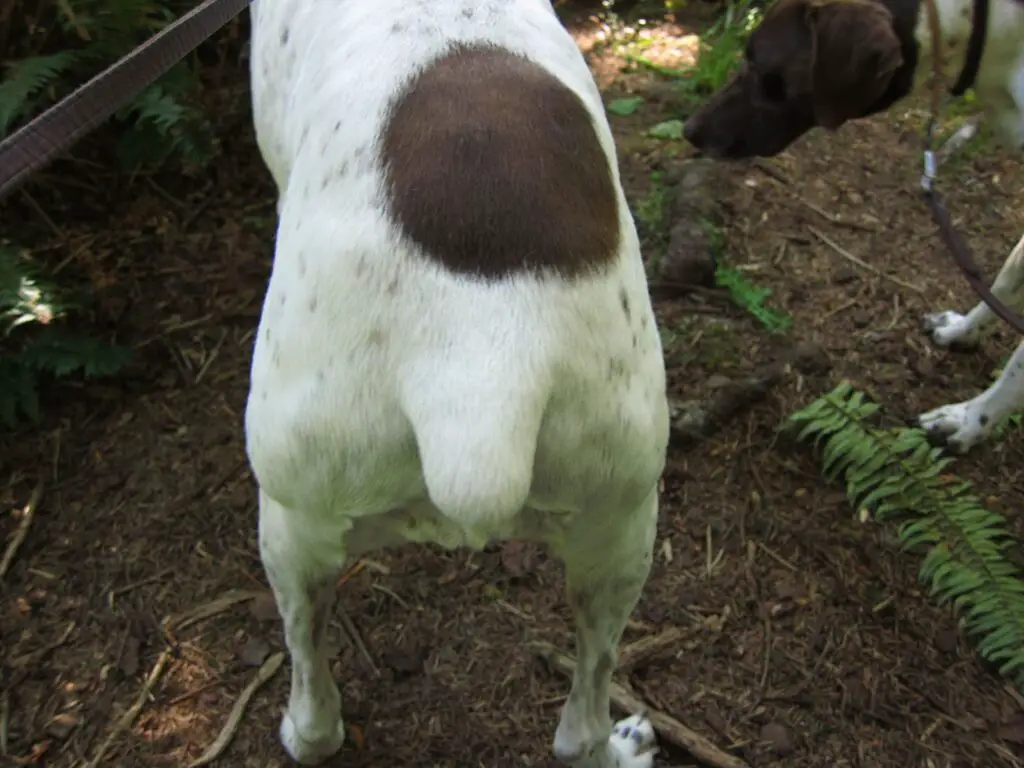Many dog owners dock their puppies’ tails to make them more visually pleasing, which is docking for aesthetic purposes and is frowned upon and banned in many countries. But it is allowed for specific breeds and reasons.
Tail docking remains controversial among dog breeders, pet owners, veterinarians, and animal welfare groups.
So, should German Shorthaired be docked? Yes, working dogs like German Shorthaired Pointers are permitted to have their tails docked if they work in certain environments where a long tail is likely to be damaged.
Let us dig deep and find out why GSPs are docked:
Reasons for Docking German Shorthaired Pointers’ Tails
The docking procedure is commonly performed on working dogs like GSPs and Spaniel Cockers because a long tail can get in the way or cause unnecessary pain.

Docking can be very painful, which is why it is not something pet dogs should go through, but there are certain medical reasons why a puppy’s tail may be docked.
1. Excessive Tail Wagging When Hunting
When hunting, GSPs tend to wag their tails excessively. As they move through the bushes and shrubs, their tails may bruise or split open, leading to painful wounds that can take a long time to heal.
The tail injuries can be really serious because these dogs do not have a thick layer of fur to protect the skin from damage.
Tail breaking and bleeding are the two most serious issues that arise when people refuse to dock their GSP’s tails. If you go on hunts with your dog, it is almost inhumane not to dock the tail.
German Shorthaired Pointers are hardworking and energetic dogs who are happiest when outdoors. It is their genetic destiny to go on hunts or indulge in other physical activities. Hence, a docked tail in working or hunting GSPs is a humanitarian modification for the dog’s sake!
2. Hyperactive in Nature
English or wire-haired Shorthaired Pointers do not necessarily need to be docked because they are mellow in nature, unlike the German Shorthaired Pointers, which are very frenzied and overly enthusiastic hunting dogs.
Even when indoors, they incessantly wag their tails against hard surfaces or pointed corners. This results in bruising of the tail and breaking of the skin.
3. Cosmetic Reasons
Unfortunately, a prevalent reason for docking a GSP’s tail is for cosmetic purposes. Many people are not used to seeing a German Shorthaired with their full tail, so they get it docked to make their dog appear more visually pleasing.
Many competitions penalize them if their tail is curled up or down while they’re moving. It should be held in line with the head and the body. This encourages GSP owners to dock their dog’s tails.
The American Veterinary Medical Association does not justify docking tails for a specific look, all the while exposing dogs to unnecessary risks, as a valid reason. The AVMA strongly opposes tail docking and ear cropping of dogs for cosmetic purposes and calls on organizations to remove such procedures from their breed standard.
When Should You Dock a GSP’s Tail?
There is no right or wrong way for a German Shorthaired Pointer’s tail to be; it simply depends on the lifestyle they are destined for.
Not all of them will have docked tails. Most breeders will dock those that fall under the right specifications, but some breeders don’t deem it necessary if they aim to sell that pup to families that just want an energetic, outdoorsy pet.

Docking the tail of your German Shorthaired Pointer should be done as soon as possible, preferably 2 or 3 days after birth. The nerves are not fully developed at this time, so the process is less painful in newborn pups. All responsible and experienced breeders do this.
Breeders also encourage tail docking at an early age because the puppies may not remember it.
If the puppy is older than five days, docking should either be left undone or strictly performed under anesthesia, ideally after eight weeks of birth. This method, however, will cost you a lot more money.
Negative Impacts of Tail Docking on Dogs
Tail docking is a painful process that can negatively affect your dog. Some of its short and long-term consequences regarding the health and welfare of your dog are:
1. Surgical Complications
Every surgery has its risks, and this one is no different. There is a potential risk of infection, necrosis, excessive bleeding, and delayed wound healing, which will only add to the existing pain.
If something goes wrong, you may have to get the whole tail amputated. The pain from the surgery may alter the development of the central nervous system. Neuromas, which have been associated with chronic pain, may also persist.
2. Behavioral Changes
Dogs use their tail to communicate with humans and other animals. By observing their tail movements, you can find out their emotional and social state.
But after getting their tails docked, they are no longer able to communicate properly, which can lead to increased aggression. Their inability to communicate also puts them at a social disadvantage among other dogs.
Conclusion
Docking dog tails has been banned in many countries, including Sweden, Germany, and Norway, for many years. Some states in the US, like Maryland and Pennsylvania, have provisions restricting the procedure.
In the UK, docking is considered illegal. It is only permitted if the concerned puppy is intended to be a working dog or if it is medically necessary.
Only genuinely working dogs with a certificate proving that they are working are permitted to have their tails docked. The dog must be certified by the breeder and the vet, and the procedure should be strictly carried out by a vet.
Overall, if it is medically necessary or a demand of the dog’s environment, it can be agreed that docking is the best way to minimize the suffering of your loyal companion.
But it should be done with the utmost care because of the muscles and the extension of the spine that reside in the tail. If done poorly, tail docking can result in chronic pain.
Frequently Asked Questions (FAQs)
Here are the answers to some of the most commonly asked questions about docking a German Shorthaired Pointer’s tail that can help new GSP owners decide whether they want to go through with the procedure or not:
1. Who can dock a GSP’s tail?
The docking procedure is medical and should only be performed by a certified veterinary surgeon. Although many vets refuse to perform this procedure, claiming it as unnecessary.
2. How long should a German Shorthaired Pointer’s tail be?
A GSP should have its tail docked to 40% of its original length, approximately 6 inches, which is the standard set by the American Kennel Club.
3. Is docking a tail cruel?
Cosmetic tail docking is cruel to dogs because it exposes them to unnecessary pain and a long healing process afterward. It is even more gruesome when done without anesthesia.
4. Is tail docking painful to puppies?
Cutting off a part of the tail requires severing muscles, tendons, bones, and cartilage connections. Since this procedure is carried out without anesthesia in newborn puppies, you can hear their shrieks during the surgery, indicating they experience extensive pain. There is also the added pain of inflammation while the wound heals.


